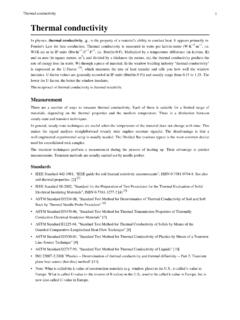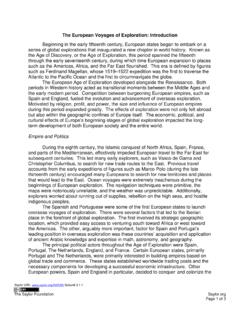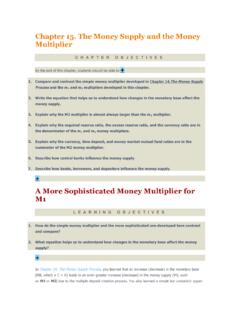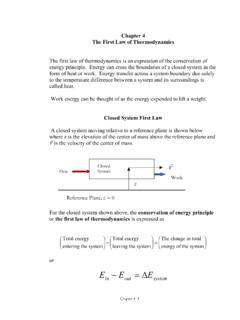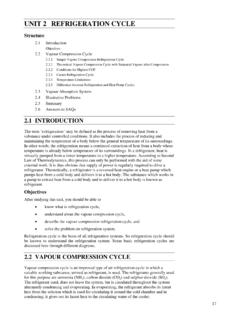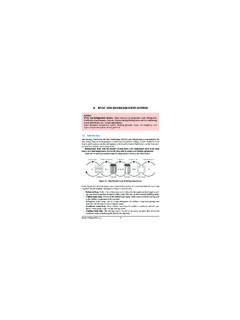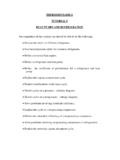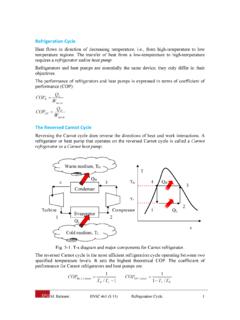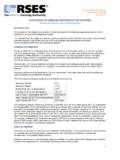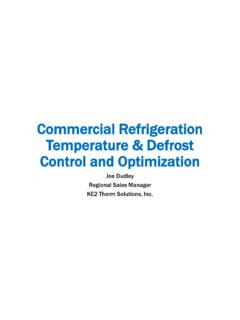Transcription of Thermodynamic cycle - Saylor Academy
1 Thermodynamic cycle1 Thermodynamic cycleA Thermodynamic cycle consists of a series of Thermodynamic processes transferring heat and work, while varyingpressure, temperature, and other state variables, eventually returning a system to its initial state.[1] In the process ofgoing through this cycle , the system may perform work on its surroundings, thereby acting as a heat quantities depend only on the Thermodynamic state, and cumulative variation of such properties adds up to zeroduring a cycle . Process quantities (or path quantities), such as heat and work are process dependent, and cumulativeheat and work are non-zero. The first law of thermodynamics dictates that the net heat input is equal to the net workoutput over any cycle . The repeating nature of the process path allows for continuous operation, making the cycle animportant concept in thermodynamics .
2 Thermodynamic cycles often use quasistatic processes to model the workingsof actual and workTwo primary classes of Thermodynamic cycles are power cycles and heat pump cycles. Power cycles are cycleswhich convert some heat input into a mechanical work output, while heat pump cycles transfer heat from low to hightemperatures using mechanical work input. Cycles composed entirely of quasistatic processes can operate as poweror heat pump cycles by controlling the process direction. On a pressure volume diagram or temperature entropydiagram, the clockwise and counterclockwise directions indicate power and heat pump cycles, to workExample of P-V diagram of a Thermodynamic the net variation in state properties during athermodynamic cycle is zero, it forms a closed loop on a PVdiagram.
3 A PV diagram's Y axis shows pressure (P) and X axisshows volume (V). The area enclosed by the loop is the work (W)done by the process:This work is equal to the balance of heat (Q) transferred into the system:Equation (2) makes a cyclic process similar to an isothermal process: even though the internal energy changes duringthe course of the cyclic process, when the cyclic process finishes the system's energy is the same as the energy it hadwhen the process the cyclic process moves clockwise around the loop, then W will be positive, and it represents a heat engine. If itmoves counterclockwise, then W will be negative, and it represents a heat cycle2 Power cyclesHeat engine power cycles are the basis for the operation ofheat engines, which supply most of the world's electric power andrun almost all motor vehicles.
4 Power cycles can be dividedaccording to the type of heat engine they seek to model. The mostcommon cycles that model internal combustion engines are theOtto cycle , which models gasoline engines and the Diesel cycle ,which models diesel engines. Cycles that model externalcombustion engines include the Brayton cycle , which models gasturbines, and the Rankine cycle , which models steam clockwise Thermodynamic cycle indicated by thearrows shows that the cycle represents a heat cycle consists of four states (the point shown bycrosses) and four Thermodynamic processes (lines).For example the pressure-volume mechanical work done in theheat engine cycle , consisting of 4 Thermodynamic processes, is:If no volume change happens in process 4->1 and 2->3, equation (3) simplifies to: Thermodynamic cycle3 Heat pump cyclesThermodynamic heat pump cycles are the models for heat pumps and refrigerators.
5 The difference between the twois that heat pumps are intended to keep a place warm while refrigerators are designed to cool it. The most commonrefrigeration cycle is the vapor compression cycle , which models systems using refrigerants that change phase. Theabsorption refrigeration cycle is an alternative that absorbs the refrigerant in a liquid solution rather than evaporatingit. Gas refrigeration cycles include the reversed Brayton cycle and the Hampson-Linde cycle . Regeneration in gasrefrigeration allows for the liquefaction of real systemsExample of a real system modelled by an idealized process: PV and TS diagrams of aBrayton cycle mapped to actual processes of a gas turbine engineThermodynamic cycles may be used tomodel real devices and systems,typically by making a series ofassumptions.
6 [2] simplifyingassumptions are often necessary toreduce the problem to a moremanageable form.[2] For example, asshown in the figure, devices such a gasturbine or jet engine can be modelledas a Brayton cycle . The actual deviceis made up of a series of stages, eachof which is itself modelled as an idealized Thermodynamic process. Although each stage which acts on the workingfluid is a complex real device, they may be modelled as idealized processes which approximate their real behavior. Afurther assumption is that the exhaust gases would be passed back through the inlet with a corresponding loss ofheat, thus completing the idealized difference between an idealized cycle and actual performance may be significant.
7 [2] For example, the followingimages illustrate the differences in work output predicted by an ideal Stirling cycle and the actual performance of aStirling engine:Ideal Stirling cycleActual performanceActual and ideal overlaid, showing difference in work outputAs work output is represented by the interior of the cycle , there is a significant difference between the predictedwork output of the ideal cycle and the actual work output shown by a real engine. It may also be observed that thereal individual processes diverge from their idealized counterparts; , isochoric expansion (process 1-2) occurswith some actual volume cycle4 Well-known Thermodynamic cyclesIn practice, simple idealized Thermodynamic cycles are usually made out of four Thermodynamic processes.
8 Anythermodynamic processes may be used. However, when idealized cycles are modeled, often processes where onestate variable is kept constant are used, such as an isothermal process (constant temperature), isobaric process(constant pressure), isochoric process (constant volume), isentropic process (constant entropy), or an isenthalpicprocess (constant enthalpy). Often adiabatic processes are also used, where no heat is example Thermodynamic cycles and their constituent processes are as follows: cycle Process 1-2(Compression)Process 2-3(Heat Addition)Process 3-4(Expansion)Process 4-1(Heat Rejection) Notes Power cycles normally with external combustion - or heat pump cycles:Bell Colemanadiabaticisobaricadiabaticisobari cA reversed Brayton cycleBraytonadiabaticisobaricadiabaticis obaricJet enginesaka first Ericsson cycle from 1833 Carnotisentropicisothermalisentropicisot hermalEricssonisothermalisobaricisotherm alisobaricthe second Ericsson cycle from 1853 Scuderiadiabaticvariablepressureand volumeadiabaticisochoricStirlingisotherm alisochoricisothermalisochoricStoddardad iabaticisobaricadiabaticisobaricPower cycles normally with internal combustion:Dieseladiabaticisobaricadiaba ticisochoricLenoirisobaricisochoricadiab aticisobaricPulse jets(Note.)
9 3 of the 4 processes are different)Ottoadiabaticisochoricadiabati cisochoricGasoline / petrol enginesRankineadiabaticisobaricadiabatic isobaricSteam engineThermodynamic cycle5 Ideal cycleAn illustration of an ideal cycle heat engine (arrows clockwise).An ideal cycle is constructed out and BOTTOM of the loop: a pair ofparallel isobaric and RIGHT of the loop: a pair ofparallel isochoric processesCarnot cycleThe Carnot cycle is a cycle composed of thetotally reversible processes of isentropiccompression and expansion and isothermal heataddition and rejection. The thermal efficiencyof a Carnot cycle depends only on the absolutetemperatures of the two reservoirs in whichheat transfer takes place, and for a power cycleis:where is the lowest cycle temperature and the highest.
10 For Carnot power cycles the coefficient ofperformance for a heat pump is:and for a refrigerator the coefficient of performance is:The second law of thermodynamics limits the efficiency and COP for all cyclic devices to levels at or below theCarnot efficiency. The Stirling cycle and Ericsson cycle are two other reversible cycles that use regeneration toobtain isothermal heat cycleA Stirling cycle is like an Otto cycle , except that the adiabats are replaced by isotherms. It is also the same as anEricsson cycle with the isobaric processes substituted for constant volume and BOTTOM of the loop: a pair of quasi-parallel isothermal and RIGHT sides of the loop: a pair of parallel isochoric processesHeat flows into the loop through the top isotherm and the left isochore, and some of this heat flows back out throughthe bottom isotherm and the right isochore, but most of the heat flow is through the pair of isotherms.




